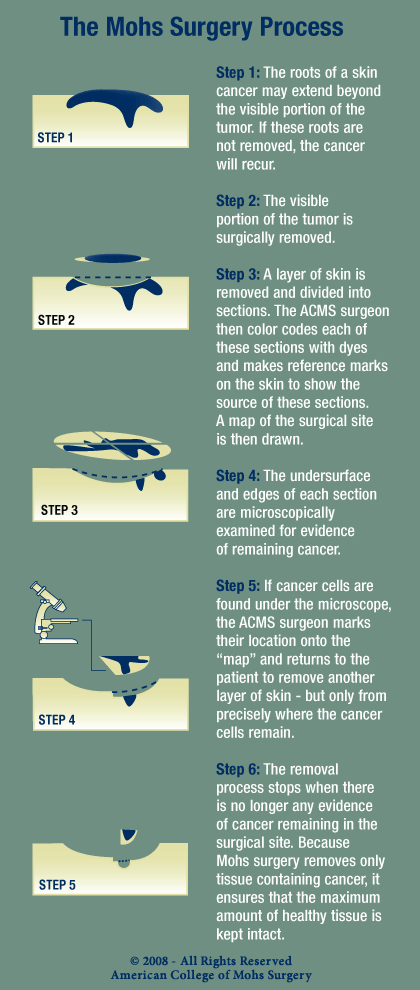Mohs Micrographic Surgery
Mohs Surgery
An advanced treatment procedure for skin cancer which offers the highest potential for recovery, even if the skin cancer has been previously treated. This procedure is state-of-the-art treatment in which the physician serves as surgeon, pathologist and reconstructive surgeon. It relies on the accuracy of a microscope to trace and ensure removal of skin cancer down to its roots.
This technique allows dermatologists, trained in Mohs surgery, to see beyond the visible disease, and to precisely identify and remove the entire tumor, leaving healthy tissue unharmed. This procedure is most often used in treating two of the most common forms of skin cancer: basal cell carcinoma and squamous cell carcinoma.
The cure rate for Mohs surgery is the highest of all treatments for skin cancer -- up to 99 % even if other forms of treatment have failed. This procedure, the most exact and precise method of tumor removal, minimizes the chance of cancer regrowth and lessens the potential for scarring and disfigurement.
History
Developed by Frederic E. Mohs, M.D. in the 1930s, the Mohs surgical procedure has been refined and perfected for more than half a century.
Effectiveness
Clinical studies have shown that Mohs surgery has a five-year cure rate up to 99 percent in the treatment of basal cell and squamous cell carcinomas.
Mohs Surgery Process
Mohs surgery is usually an outpatient procedure performed in a physician's office. Typically, it starts early in the morning and can be completed the same day, depending on the extent of the tumor and the amount or reconstruction necessary. Local anesthesia is administered around the area of the tumor so the patient is awake during the entire procedure.
Procedure

Reconstruction
The best method of managing the wound resulting from surgery is determined after the cancer is completely removed. When the final defect is known, management is individualized to achieve the best results and to preserve function and maximize aesthetics. The Mohs surgeon is also trained in reconstructive procedures and often will perform the reconstructive procedure necessary to repair the wound.
Cost Effectiveness
Besides its high cure rate, Mohs surgery has shown to be cost effective. In a study of costs of various types of skin cancer removal, the Mohs process was found to be comparable when compared to the cost of other procedures, such as electrodesiccation and curettage, cryosurgery, excision or radiation therapy. Mohs surgery preserves the maximum amount of normal skin which results in smaller scars. Repairs are more often simple and involve fewer complicated reconstructive procedures.
The Mohs Surgeon
The highly-trained surgeons that perform Mohs surgery are specialists both in dermatology and pathology. With their extensive knowledge of the skin and unique pathological skills, they are able to remove only diseased tissue, preserving healthy tissue and minimizing the cosmetic impact of the surgery.
Dr. Sanjay Bhambri is a fellowship trained Mohs surgeon. He completed his Mohs Surgery and Procedural Dermatology fellowship at Arkansas Skin Cancer Center, a program recognized and approved by the American College of Mohs Surgery (ACMS) and The Accreditation Council for Graduate Medical Education (ACGME).
The Mohs College currently recognizes more than 50 training centers where qualified applicants receive comprehensive training in Mohs surgery. The minimum training period is one year during which the dermatologist acquires extensive experience in all aspects of Mohs surgery, pathology and training in reconstructive surgery.



